Distribution Model of Fluid Components and Quantitative Calculation of Movable Oil in Inter-Salt Shale Using 2D NMR
Abstract
1. Introduction
2. NMR Principles
3. Samples and Experiments
3.1. Two Types of Inter-Salt Shale Samples
3.2. A Novel Experimental Procedure
- (1)
- Sample wrapping and original-state NMR test: Each prepared cylindrical sample was wrapped using a plastic film to prevent possible physical damage in the subsequent experiments. Then, the NMR tests were conducted in the original state before saturation. It is worth noting that the wrapping film was made of a specific plastic that did not produce any NMR signal to guarantee the originality of the test results.
- (2)
- NMR test after oil absorption: First, both oil and shale samples were put into the vacuum core saturation machine. Then, cylindrical samples were vacuumed for 8 h and absorbed oil without the external pressure for 30 days. Finally, the oil on the samples’ external surface was cleaned and 1D NMR T2 spectrum and 2D T1-T2 maps were measured.
- (3)
- NMR test of the oil-saturated sample: Oil-saturated shale samples were prepared under three external pressures. The inter-salt shale in this area has high brittle mineral content (average 56%) and high brittleness index (average 75.3) [50]. It was found that when the external pressure was over 2000 psi, the micro-fracture would exist. Therefore, the maximum external pressure of our research was 2000 psi. The cylindrical samples were put into the vacuum core saturation machine under external pressures of 500, 1000, and 2000 psi, respectively. Each saturation state was kept for 7 days. Then, both 1D and 2D NMR measurements were carried out at each of these saturation states.
- (4)
- NMR test after oil-washing and adding octamethylcyclotetrasiloxane (D4): These shale samples were washed with alcohol and toluene, and then both clean samples and D4 were put into the vacuum core saturation machine and the pressure was set to 2000 psi.
- (1)
- Original-state NMR test: Twenty grams of the powder sample were wrapped with a plastic film to prevent the powder loss in subsequent experiments and the 1D and 2D NMR signals of the original samples were measured.
- (2)
- Multi-temperature heating of powder samples: Using particularly designed stepwise multi-temperature anaerobic heating equipment, five parts of each powder sample were heated to 80, 200, 350, 450, and 600 °C, respectively. Five different temperature values were adopted from the study of Jiang et al. [52], which related to different types of hydrocarbon fractions (free movable oil, free residual oil, adsorbed oil, and kerogen). When the temperature rises up to 600 °C, no residual oil or adsorbed oil exists in the inter-salt shale powder sample. Then, the T2 spectrum and T1-T2 maps of these powder samples were measured.
4. Distribution Patterns of Different Fluid Components of Inter-Salt Shale
4.1. Distribution Pattern of Free Movable Oil in Inter-Salt Shale
4.2. Distribution Pattern of Water in Inter-Salt Shale
4.3. Distribution Pattern of Free Residual Oil and Other Components in Inter-Salt Shale
5. Calculating the Fluid Saturation of Inter-Salt Shale
- (1)
- The amount of oil that enters the pore space of the cylindrical sample under 2000 psi saturation compared to the original state is the moveable part of the free oil, simply referred to as free movable oil.
- (2)
- The amount of oil in the powder sample heated at 350 °C compared to the original state is free residual oil.
- (3)
- The amount of oil in the powder sample between 450 °C and 350 °C heating is adsorption oil.
6. Conclusions
- (1)
- When it is not feasible to study the NMR signal of the water within the pore space of the sample through direct water saturation because of the mineralogical nature of the sample, the relevant experiment can be carried out using D4, which behaves similar to water under the NMR test and has obtained a similar signal.
- (2)
- Through the measurement of the 2D T1-T2 maps of the cylindrical and powder samples in 11 different states, the similarities were summarized, and the fluid component identification graph of inter-salt shale was obtained. It was found that the T2 value of the free movable oil was mainly between 1.7 and 13 ms, and the T1 value was mainly between 20 and 290 ms.
- (3)
- In the present research, the particularly designed stepwise multi-temperature anaerobic heating equipment and NMR machine were used together to calculate the saturation of free movable oil by the T2 spectrum accumulation method, which could be used as an important basis for the development of shale oil.
Author Contributions
Funding
Institutional Review Board Statement
Informed Consent Statement
Data Availability Statement
Conflicts of Interest
References
- Dong, H.; Sun, J.; Arif, M.; Golsanami, N.; Yan, W.; Zhang, Y. A Novel Hybrid Method for Gas Hydrate Filling Modes Identification Via Digital Rock. Mar. Petrol. Geol. 2020, 115, 104255. [Google Scholar] [CrossRef]
- Qiang, Z.; Yasin, Q.; Golsanami, N.; Du, Q. Prediction of reservoir quality from log-core and seismic inversion analysis with an artificial neural network: A case study from the Sawan gas field, Pakistan. Energies 2020, 13, 486. [Google Scholar] [CrossRef]
- Bakhshi, E.; Golsanami, N.; Chen, L. Numerical Modeling and Lattice Method for Characterizing Hydraulic Fracture Propagation: A Review of the Numerical, Experimental, and Field Studies. Arch. Comput. Method. E. 2020, 1–32. [Google Scholar] [CrossRef]
- Yasin, Q.; Du, Q.; Ismail, A. A new integrated workflow for improving permeability estimation in a highly heterogeneous reservoir of Sawan Gas Field from well logs data. Geomech. Geophys. Geo-Energy Geo-Resour. 2019, 5, 121–142. [Google Scholar] [CrossRef]
- Feng, Q.; Xu, S.; Xing, X.; Zhang, W.; Sen, W. Advances and challenges in shale oil development: A critical review. Adv. Geo-Energy Res. 2020, 4, 406–418. [Google Scholar] [CrossRef]
- Li, X.; Yin, H.Y.; Zhang, R.S.; Cui, J.; Wu, J.; Feng, Y.J. A salt-induced viscosifying smart polymer for fracturing inter-salt shale oil reservoirs. Petro. Sci. 2019, 16, 816–829. [Google Scholar] [CrossRef]
- Yang, Z.; Li, R.; Li, H.; Luo, Y.; Chen, T.; Gao, T.; Zhang, Y. Experimental evaluation of the salt dissolution in inter-salt shale oil reservoirs. Petro. Explor. Dev. 2020, 47, 803–809. [Google Scholar] [CrossRef]
- Fan, X.; Su, J.Z.; Chang, X.; Huang, Z.W.; Zhou, T.; Guo, Y.T.; Wu, S.Q. Brittleness evaluation of the inter-salt shale oil reservoir in Jianghan Basin in China. Mar. Petrol. Geol. 2019, 102, 109–115. [Google Scholar] [CrossRef]
- Almutairi, Z.; Al-Alweet, F.M.; Alghamdi, Y.A.; Almisned, O.A.; Alothman, O.Y. Investigating the characteristics of two-phase flow using electrical capacitance tomography (ECT) for three pipe orientations. Processes 2020, 8, 51. [Google Scholar] [CrossRef]
- Xu, Z.; Wu, F.; Yang, X.; Li, Y. Measurement of gas-oil two-phase flow patterns by using CNN algorithm based on dual ECT sensors with venturi tube. Sensors 2020, 20, 1200. [Google Scholar] [CrossRef] [PubMed]
- Roshani, M.; Phan, G.T.; Ali, P.J.M.; Roshani, G.H.; Hanus, R.; Duong, T.; Corniani, E.; Nazemi, E.; Kalmoun, E.M. Evaluation of flow pattern recognition and void fraction measurement in two phase flow independent of oil pipeline’s scale layer thickness. Alex. Eng. J. 2021, 60, 1955–1966. [Google Scholar] [CrossRef]
- Roshani, M.; Phan, G.; Roshani, G.H.; Hanus, R.; Nazemi, B.; Corniani, E.L.; Nazemi, E. Combination of X-ray tube and GMDH neural network as a nondestructive and potential technique for measuring characteristics of gas-oil–water three phase flows. Measurement 2021, 168, 108427. [Google Scholar] [CrossRef]
- Zhang, Y.; Azman, A.N.; Xu, K.W.; Kang, C.; Kim, H.B. Two-phase flow regime identification based on the liquid-phase velocity information and machine learning. Exp. Fluids 2020, 61, 1–16. [Google Scholar] [CrossRef]
- Michal, C.A. Low-cost low-field NMR and MRI: Instrumentation and applications. J. Magn. Reson. 2020, 319, 106800. [Google Scholar] [CrossRef]
- Golsanami, N.; Sun, J.; Zhang, Z. A review on the applications of the nuclear magnetic resonance (NMR) technology for investigating fractures. J. Appl. Geophys. 2016, 133, 30–38. [Google Scholar] [CrossRef]
- Song, Y.Q.; Kausik, R. NMR application in unconventional shale reservoirs-A new porous media research frontier. Prog. Nucl. Mag. Res. Sp. 2019, 112, 17–33. [Google Scholar] [CrossRef]
- Liu, Z.; Liu, D.; Cai, Y.; Yao, Y.; Pan, Z.; Zhou, Y. Application of nuclear magnetic resonance (NMR) in coalbed methane and shale reservoirs: A review. Int. J. Coal Geol. 2020, 218, 103261. [Google Scholar] [CrossRef]
- Golsanami, N.; Sun, J.; Liu, Y.; Yan, W.; Lianjun, C.; Jiang, L.; Dong, H.; Zong, C.; Wang, H. Distinguishing fractures from matrix pores based on the practical application of rock physics inversion and NMR data: A case study from an unconventional coal reservoir in China. J. Nat. Gas. Sci. Eng. 2019, 65, 145–167. [Google Scholar] [CrossRef]
- Sun, B.Q.; Dunn, K.J. Multi-dimensional NMR logging. J. Magn. Reson. 2005, 172, 152–160. [Google Scholar] [CrossRef] [PubMed]
- Golsanami, N.; Bakhshi, E.; Yan, W.; Dong, H.; Barzgar, E.; Zhang, G.; Mahbaz, B. Relationships between the geomechanical parameters and Archie’s coefficients of fractured carbonate reservoirs: A new insight. Energ. Source Part. A 2020, 1–25. [Google Scholar] [CrossRef]
- Wang, M.; Xie, J.; Guo, F.; Zhou, Y.; Yang, X.; Meng, Z. Determination of NMR T2 Cutoff and CT Scanning for Pore Structure Evaluation in Mixed Siliciclastic–Carbonate Rocks before and after Acidification. Energies 2020, 13, 1338. [Google Scholar] [CrossRef]
- Golsanami, N.; Zhang, X.; Yan, W.; Yu, L.; Dong, H.; Dong, X.; Cui, L.; Jayasuriya, M.N.; Fernando, S.G.; Barzgar, E. NMR-Based Study of the Pore Types’ Contribution to the Elastic Response of the Reservoir Rock. Energies 2021, 14, 1513. [Google Scholar] [CrossRef]
- Walsh, D.; Turner, P.; Grunewald, E.; Zhang, H.; Butler, J.J., Jr.; Reboulet, E.; Knobbe, S.; Christy, T.; Lane, J.W., Jr.; Johnson, C.D.; et al. A small-diameter NMR logging tool for groundwater investigations. Groundwater 2013, 51, 914–926. [Google Scholar] [CrossRef] [PubMed]
- Golsanami, N.; Sun, J. Developing a new technique for estimating NMR T1 and T2 relaxations. In Proceedings of the 79th EAGE Conference and Exhibition, Paris, France, 12–15 June 2017. [Google Scholar]
- Zargar, G.; Tanha, A.A.; Parizad, A.; Amouri, M.; Bagheri, H. Reservoir rock properties estimation based on conventional and NMR log data using ANN-Cuckoo: A case study in one of super fields in Iran southwest. Petroleum 2020, 6, 304–310. [Google Scholar] [CrossRef]
- Zemansky, G.M.; McElwee, C.D. High-resolution slug testing. Groundwater 2005, 43, 222–230. [Google Scholar] [CrossRef] [PubMed]
- Tan, M.; Zou, Y.; Zhou, C. A new inversion method for (T2, D) 2D NMR logging and fluid typing. Comput. Geosci. 2013, 51, 366–380. [Google Scholar] [CrossRef]
- Guo, J.; Xie, R. Numerical simulation and parameter analysis of NMR T2-D distributions of tight sandstone saturated with a gas-water two-phase fluid. J. Nat. Gas. Sci. Eng. 2017, 37, 502–511. [Google Scholar] [CrossRef]
- Hu, F.; Zhou, C.; Li, C.; Xu, H.; Zhou, F.; Si, Z. Fluid identification method based on 2D diffusion-relaxation nuclear magnetic resonance (NMR). Petrol. Explor. Dev. 2012, 39, 591–596. [Google Scholar] [CrossRef]
- Hürlimann, M.D.; Venkataramanan, L. Quantitative measurement of two-dimensional distribution functions of diffusion and relaxation in grossly inhomogeneous fields. J. Magn. Reson. 2002, 157, 31–42. [Google Scholar] [CrossRef] [PubMed]
- Liu, H.; Nogueira d’Eurydice, M.; Obruchkov, S.; Galvosas, P. Determining pore length scales and pore surface relaxivity of rock cores by internal magnetic fields modulation at 2MHz NMR. J. Magn. Reson. 2014, 246, 110–118. [Google Scholar] [CrossRef] [PubMed]
- Medina-Rodriguez, B.X.; Reilly, T.; Wang, H.; Smith, E.R.; Garcia-Olvera, G.; Alvarado, V.; Aryana, S. Time-Domain Nuclear Magnetic Resonance Determination of Wettability Alteration: Analysis for Low-Salinity Water. Appl. Sci. 2020, 10, 1017. [Google Scholar] [CrossRef]
- Kausik, R.; Minh, C.C.; Zielinski, L.; Vissapragada, B.; Akkurt, R.; Song, Y. Characterization of gas dynamics in kerogen nanopores by NMR. In Proceedings of the SPE Annual Technical Conference and Exhibition, Denver, CO, USA, 30 October–2 November 2011. [Google Scholar]
- Korb, J.P.; Nicot, B.; Louis-Joseph, A.; Bubici, S.; Ferrante, G. Dynamics and wettability of oil and water in oil shales. J. Phys. Chem. C. 2014, 118, 23212–23218. [Google Scholar] [CrossRef]
- Washburn, K.; Birdwell, J.E. A new laboratory approach to shale analysis using NMR relaxometry. In Proceedings of the Unconventional Resources Technology Conference, Denver, CO, USA, 12–14 August 2013. [Google Scholar]
- Birdwell, J.E.; Washburn, K.E. Multivariate analysis relating oil shale geochemical properties to NMR relaxometry. Energ. Fuel. 2015, 29, 34–43. [Google Scholar] [CrossRef]
- Yan, W.; Sun, J.; Cheng, Z.; Li, J.; Sun, Y.; Shao, W.; Shao, Y. Petrophysical characterization of tight oil formations using 1D and 2D NMR. Fuel 2017, 206, 89–98. [Google Scholar] [CrossRef]
- Yan, W.; Sun, J.; Golsanami, N.; Li, M.; Cui, L.; Dong, H.; Sun, Y. Evaluation of wettabilities and pores in tight oil reservoirs by a new experimental design. Fuel 2019, 252, 272–280. [Google Scholar] [CrossRef]
- Zhang, P.; Lu, S.; Li, J.; Chang, X. 1D and 2D Nuclear magnetic resonance (NMR) relaxation behaviors of protons in clay, kerogen and oil-bearing shale rocks. Mar. Petrol. Geol. 2020, 114, 104210. [Google Scholar] [CrossRef]
- Freedman, R.; Lo, S.; Flaum, M.; Hirasaki, G.J.; Matteson, A.; Sezginer, A. A new NMR method of fluid characterization in reservoir rocks: Experimental confirmation and simulation results. Spe. J. 2001, 6, 452–464. [Google Scholar] [CrossRef]
- Venkataramanan, L.; Evirgen, N.; Allen, D. An unsupervised learning algorithm to compute fluid volumes from NMR T1-T2 logs in unconventional reservoirs. Proceedings of SPWLA 59th Annual Logging Symposium, London, UK, 2–6 June 2018. [Google Scholar]
- House, W.V. Introduction to the Principles of NMR. IEEE Trans. Nucl. Sci. 1980, 27, 1219–1226. [Google Scholar] [CrossRef]
- Kleinberg, R.L.; Horsfield, M.A. Transverse relaxation processes in porous sedimentary rock. J. Magn. Reson. 1990, 88, 9–19. [Google Scholar] [CrossRef]
- Brownstein, K.R.; Tarr, C.E. Importance of classical diffusion in NMR studies of water in biological cells. Phys. Rev. A. 1979, 19, 2446–2453. [Google Scholar] [CrossRef]
- Cohen, M.H.; Mendelson, K.S. Nuclear magnetic relaxation and the internal geometry of sedimentary rocks. J. Appl. Phys. 1982, 53, 1127–1135. [Google Scholar] [CrossRef]
- Du, Q.; Xiao, L.; Zhang, Y.; Liao, G.; Liu, H.; Guo, J. A novel two-dimensional NMR relaxometry pulse sequence for petrophysical characterization of shale at low field. J. Magn. Reson. 2019, 310, 106643. [Google Scholar] [CrossRef]
- Bloembergen, N.; Purcell, E.M.; Pound, R.V. Relaxation effects in nuclear magnetic resonance absorption. Phys. Rev. 1948, 73, 679–712. [Google Scholar] [CrossRef]
- Santoso, R.; Torrealba, V.; Hoteit, H. Investigation of an Improved Polymer Flooding Scheme by Compositionally-Tuned Slugs. Processes 2020, 8, 197. [Google Scholar] [CrossRef]
- Leu, S.-S.; Ying, T.-M. Replacement and Maintenance Decision Analysis for Hydraulic Machinery Facilities at Reservoirs under Imperfect Maintenance. Energies 2020, 13, 2507. [Google Scholar] [CrossRef]
- Wang, F.; Sheng, H.; Youheng, Z.; Shiqiang, W. Mineral composition and brittleness characteristics of the inter-salt shale oil reservoirs in the Qianjiang Formation, Qianjiang Sag. Petrol. Geol. Exp. 2016, 38, 211–218. (In Chinese) [Google Scholar]
- Scheeder, G.; Weniger, P.; Blumenberg, M. Geochemical implications from direct Rock-Eval pyrolysis of petroleum. Org. Geochem. 2020, 146, 104051. [Google Scholar] [CrossRef]
- Jiang, Q.; Li, M.; Qian, M.; Li, Z.; Li, Z.; Huang, Z.; Zhang, C.; Ma, Y. Quantitative characterization of shale oil in different occurrence states and its application. Petro. Geol. Exp. 2016, 38, 842–849. (In Chinese) [Google Scholar]
- Johannes, I.; Kruusement, K.; Veskib, R. Evaluation of oil potential and pyrolysis kinetics of renewable fuel and shale samples by Rock-Eval analyzer. J. Anal. Appl. Pyrol. 2007, 79, 183–190. [Google Scholar] [CrossRef]
- Liu, B.; Yao, S.; Hu, W.; Cao, J. Applying octamethylcyclotetrasiloxane as a probe liquid for characterizing the pore size distribution of oil-bearing tight sandstones by nuclear magnetic resonance cryoporometry. Mar. Petrol. Geol. 2017, 88, 814–825. [Google Scholar] [CrossRef]
- Khatibi, S.; Ostadhassan, M.; Xie, Z.H.; Gentzis, T.; Bubach, B.; Gan, Z.; Carvajal-Ortizb, H. NMR relaxometry a new approach to detect geochemical properties of organic matter in tight shales. Fuel 2019, 235, 167–177. [Google Scholar] [CrossRef]
- Dong, X.; Shen, L.W.; Golsanami, N.; Liu, X.; Sun, Y.; Wang, F.; Shi, Y.; Sun, J. How N-2 injection improves the hydrocarbon recovery of CO2 HnP: An NMR study on the fluid displacement mechanisms. Fuel 2020, 278, 118286. [Google Scholar] [CrossRef]
- Jiang, L.; Zhao, Y.; Golsanami, N.; Chen, L.; Yan, W. A novel type of neural networks for feature engineering of geological data: Case studies of coal and gas hydrate-bearing sediments. Geosci. Front. 2020, 11, 1511–1531. [Google Scholar] [CrossRef]
- Luo, K. Study on reserves characteristics of intersalt shale oil in Qianjiang Depression. J. Jianghan Petrol. Univ. Staff Work. 2020, 33, 38–40. (In Chinese) [Google Scholar]
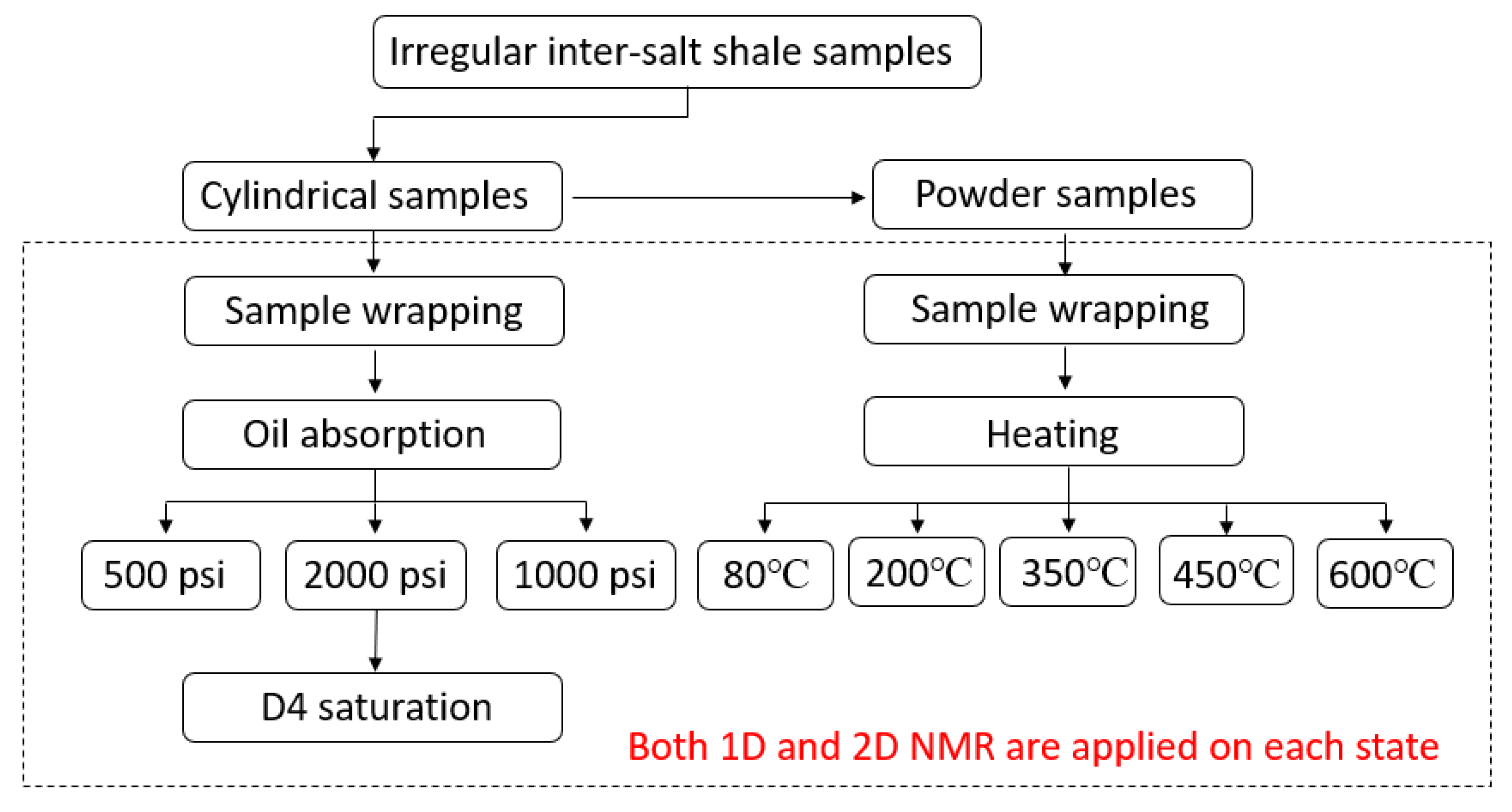

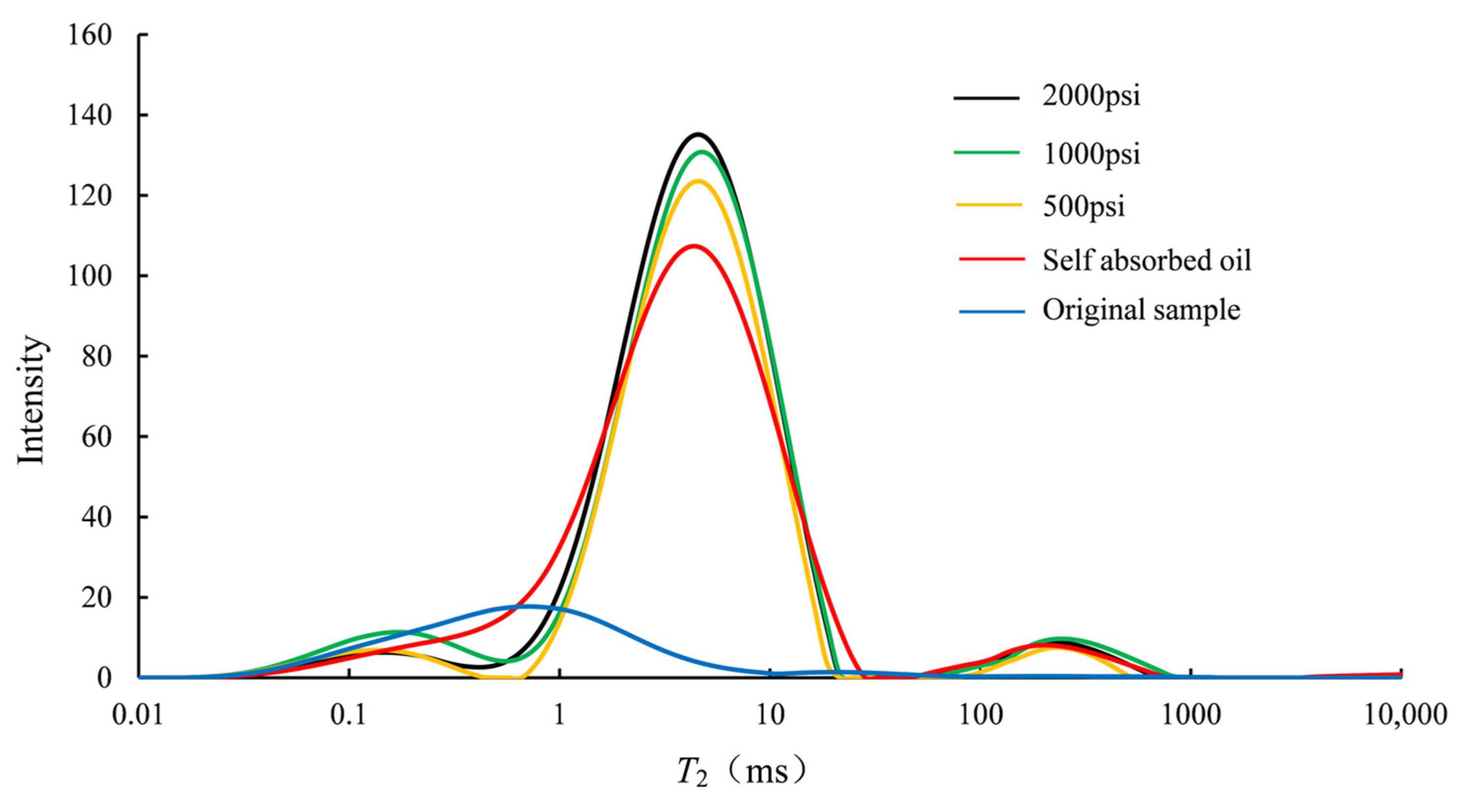

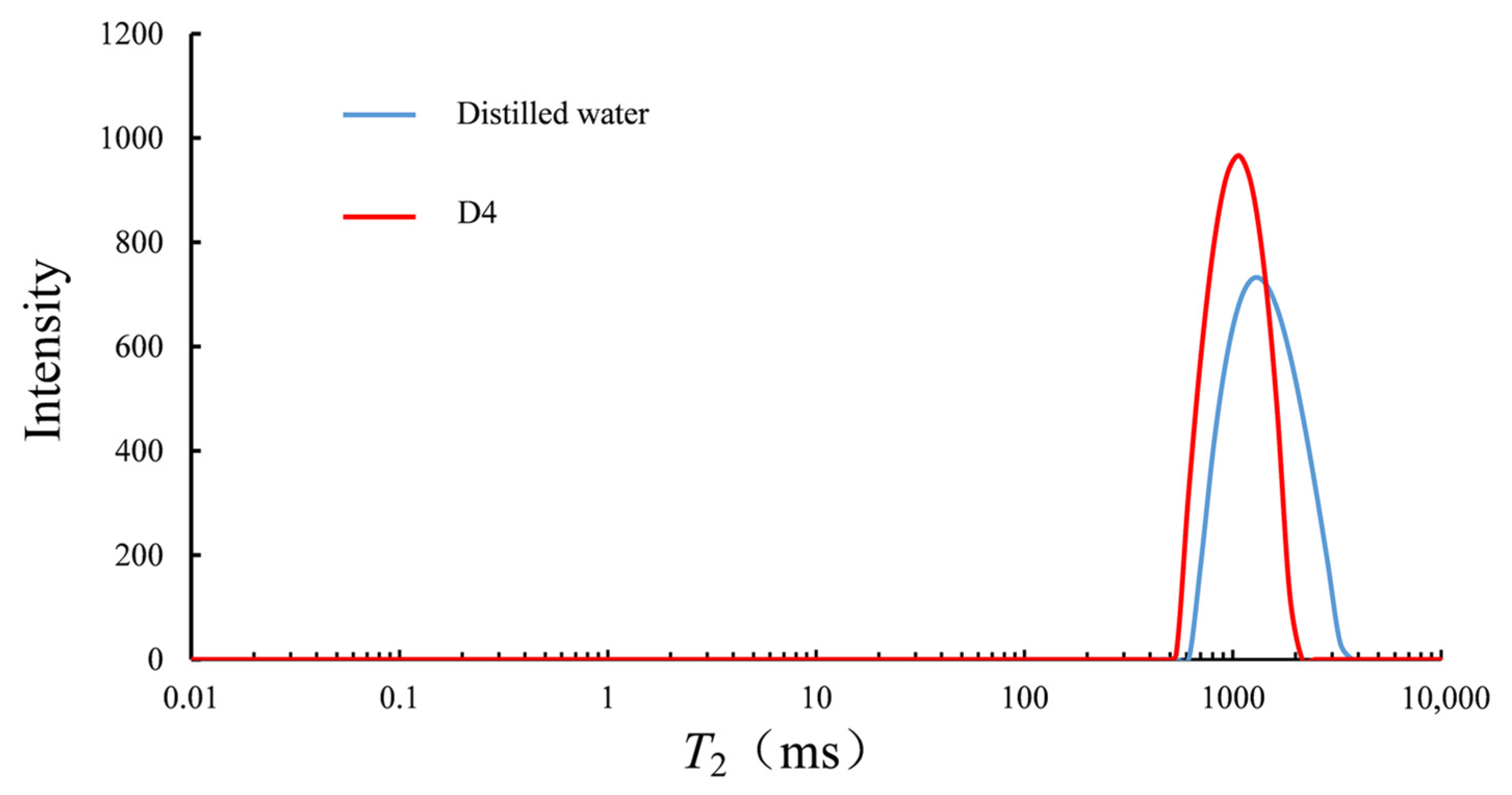
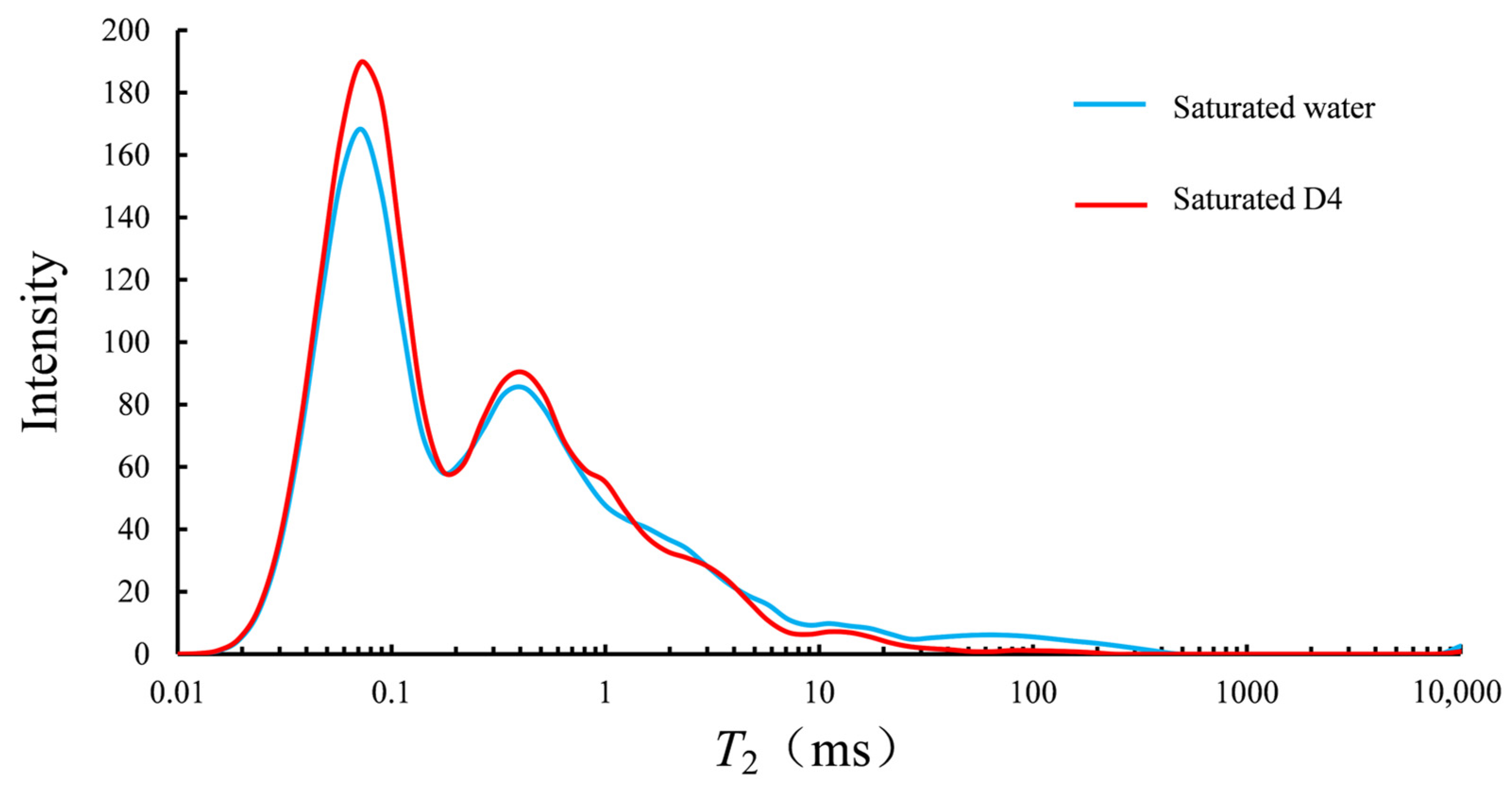
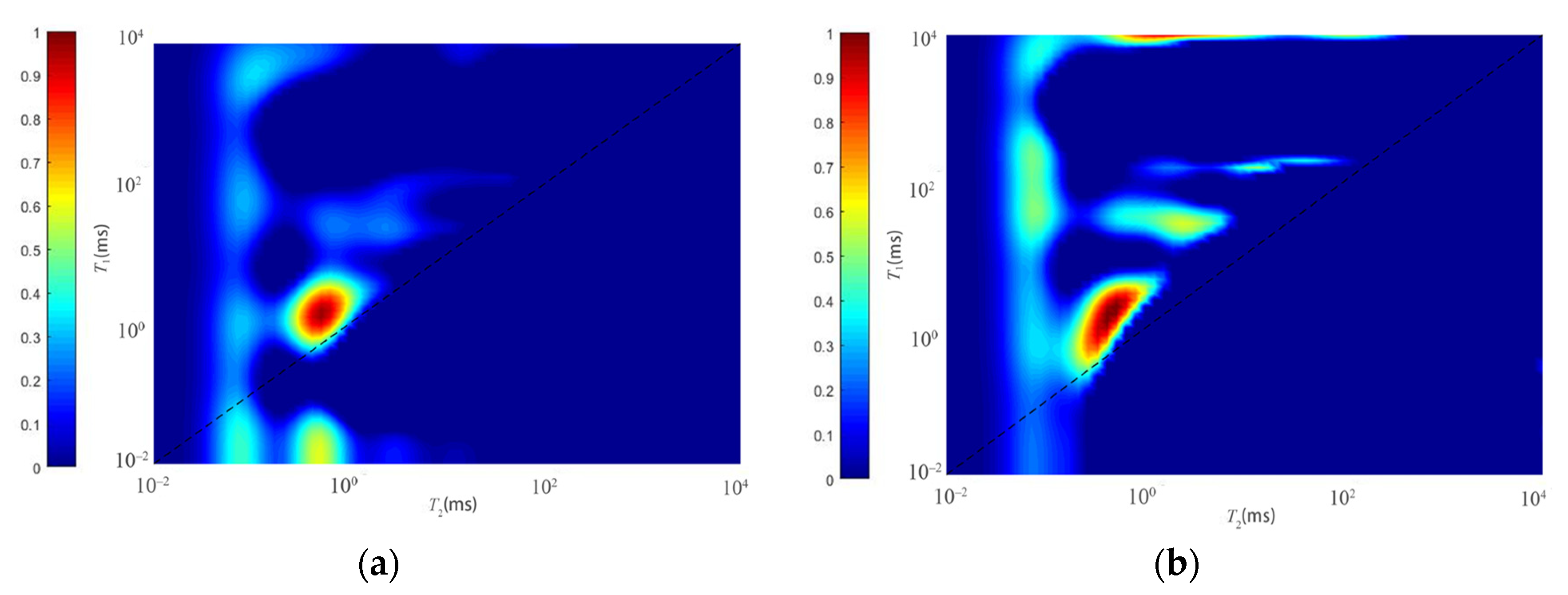
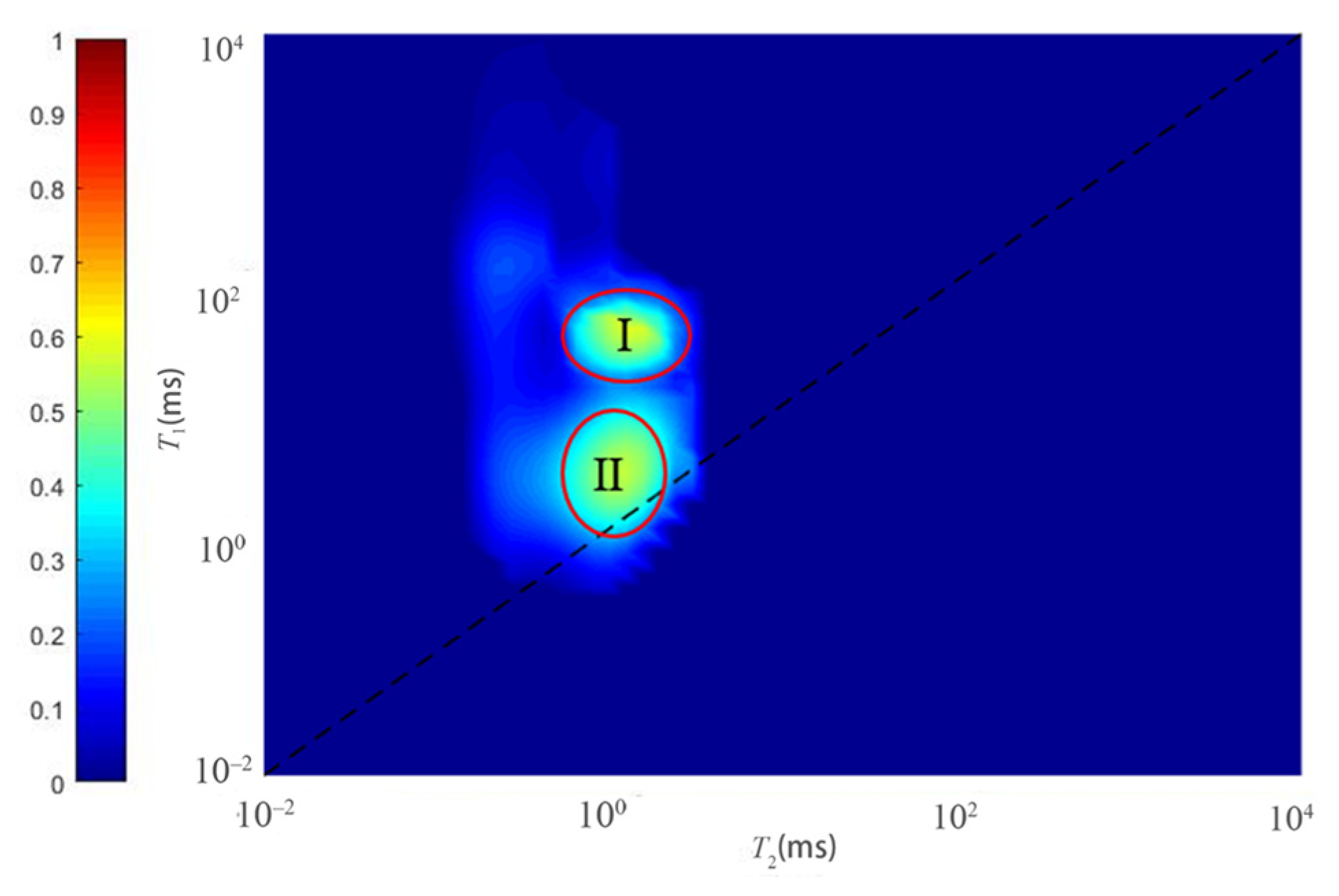

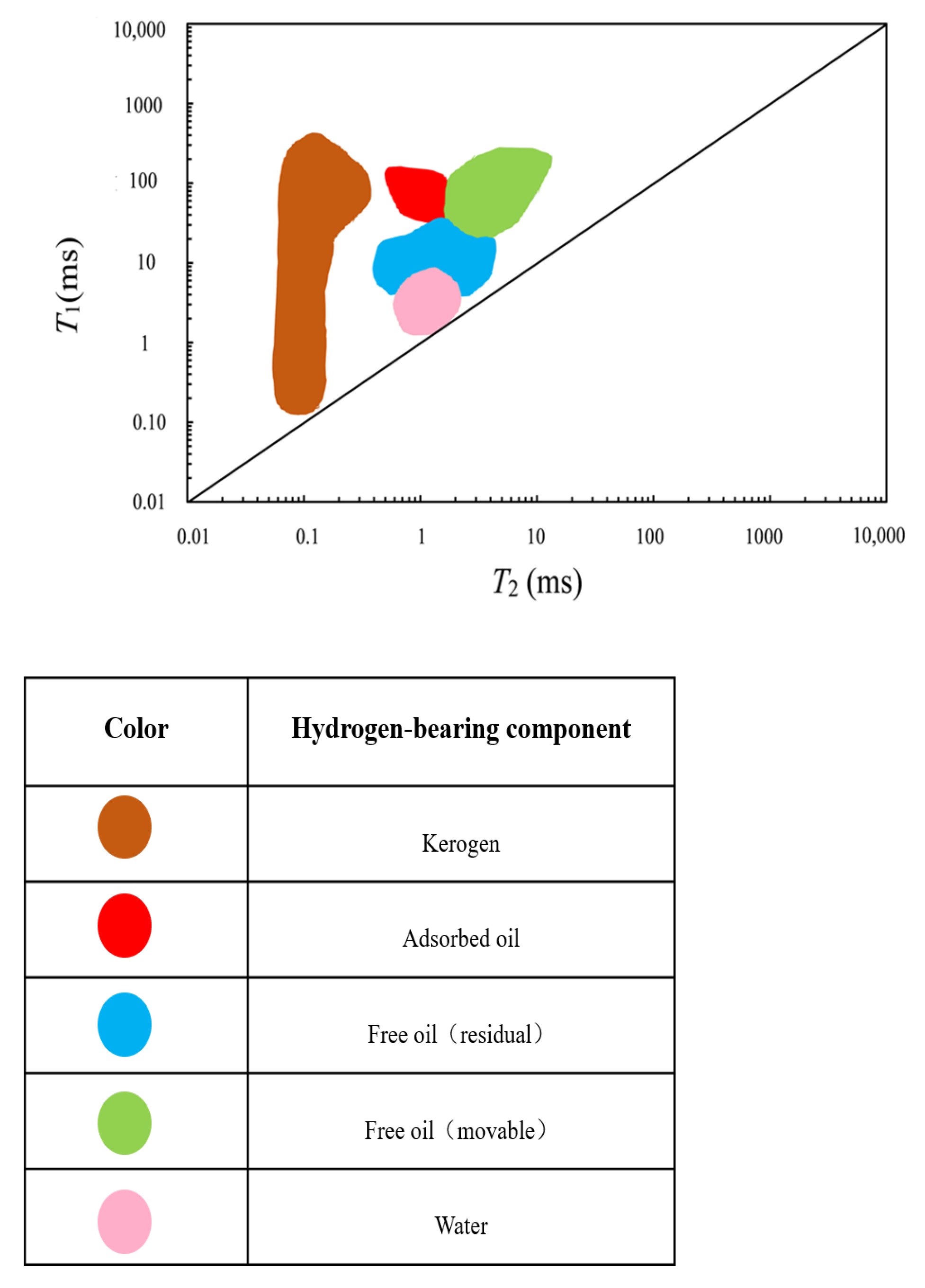
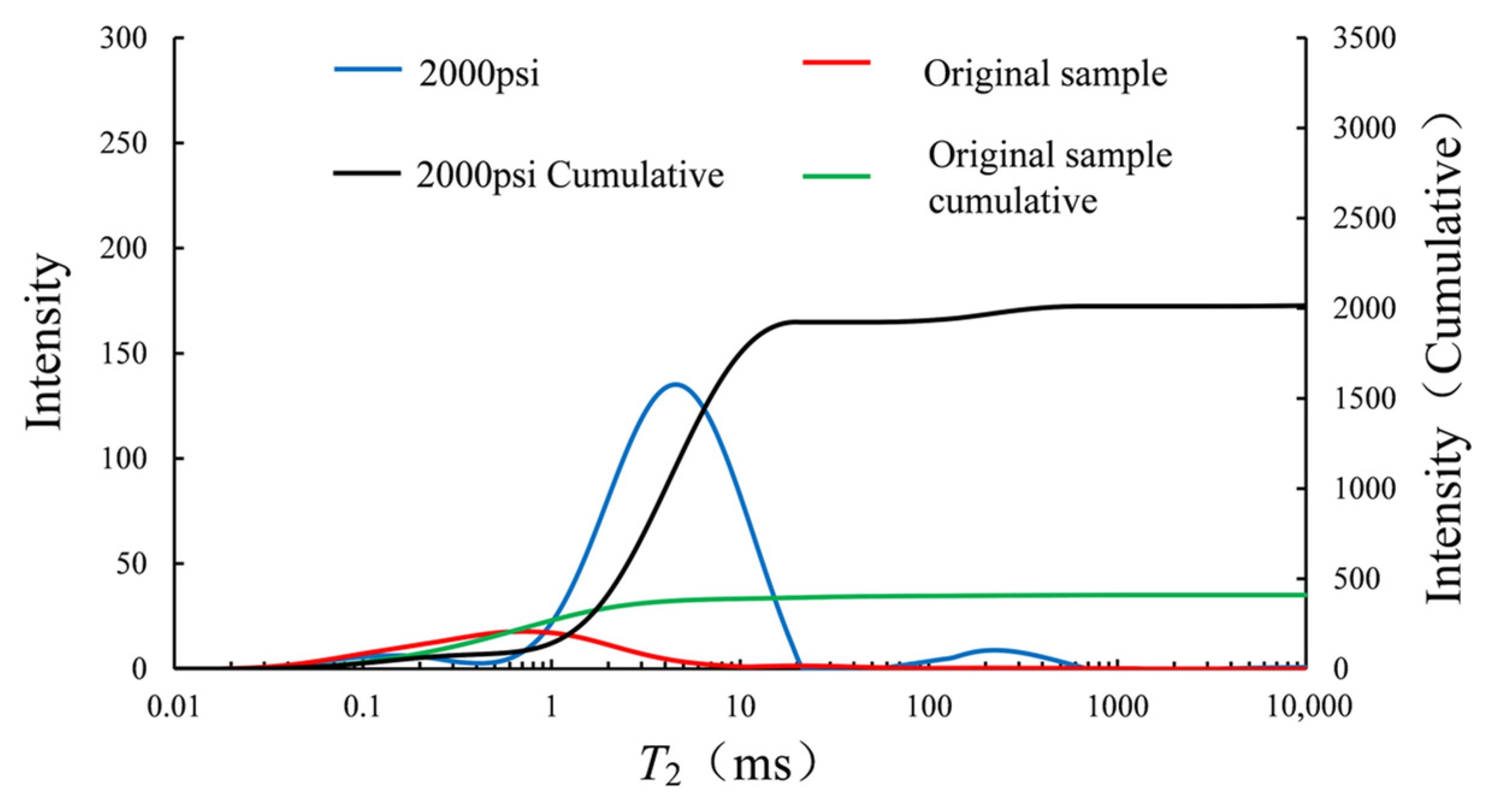
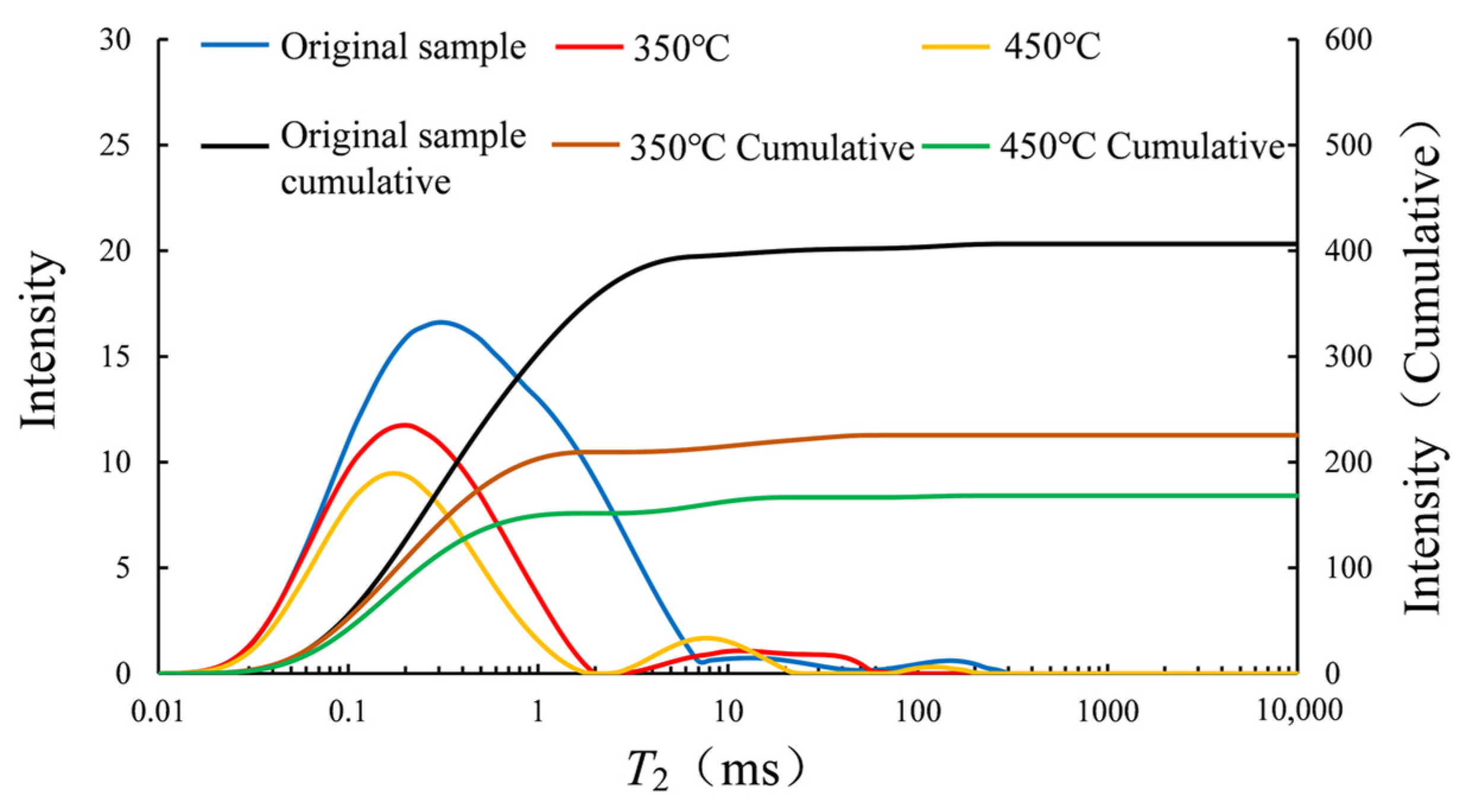
| Component Name | T1 (ms) | T2(ms) | T1/T2 |
|---|---|---|---|
| Free oil (movable) | 20–290 | 1.7–13 | 4–50 |
| Free oil (residue) | 3.5–35 | 0.4–5 | 1.3–40 |
| Adsorption oil | 34–150 | 1.5–2 | 16–300 |
| Water | 1–8 | 0.5–2 | 1–10 |
| Kerogen | 0.13–428 | 0.05–0.4 | 1–4100 |
| Sample 1 | Sample 2 | Sample 3 | Sample 4 | Sample 5 | Sample 6 | Average | |
|---|---|---|---|---|---|---|---|
| Free movable oil saturation/% | 86.93 | 70.8 | 80.87 | 73.24 | 76.68 | 78.21 | 77.79 |
| Free residual oil saturation/% | 9.91 | 20 | 12.79 | 17.32 | 15.1 | 17.48 | 15.43 |
| Adsorbed oil saturation/% | 3.16 | 9.2 | 6.34 | 9.44 | 8.22 | 4.31 | 6.79 |
Publisher’s Note: MDPI stays neutral with regard to jurisdictional claims in published maps and institutional affiliations. |
© 2021 by the authors. Licensee MDPI, Basel, Switzerland. This article is an open access article distributed under the terms and conditions of the Creative Commons Attribution (CC BY) license (https://creativecommons.org/licenses/by/4.0/).
Share and Cite
Yan, W.; Sun, F.; Sun, J.; Golsanami, N. Distribution Model of Fluid Components and Quantitative Calculation of Movable Oil in Inter-Salt Shale Using 2D NMR. Energies 2021, 14, 2447. https://doi.org/10.3390/en14092447
Yan W, Sun F, Sun J, Golsanami N. Distribution Model of Fluid Components and Quantitative Calculation of Movable Oil in Inter-Salt Shale Using 2D NMR. Energies. 2021; 14(9):2447. https://doi.org/10.3390/en14092447
Chicago/Turabian StyleYan, Weichao, Fujing Sun, Jianmeng Sun, and Naser Golsanami. 2021. "Distribution Model of Fluid Components and Quantitative Calculation of Movable Oil in Inter-Salt Shale Using 2D NMR" Energies 14, no. 9: 2447. https://doi.org/10.3390/en14092447
APA StyleYan, W., Sun, F., Sun, J., & Golsanami, N. (2021). Distribution Model of Fluid Components and Quantitative Calculation of Movable Oil in Inter-Salt Shale Using 2D NMR. Energies, 14(9), 2447. https://doi.org/10.3390/en14092447







